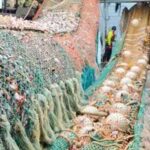
JUNEAU, AK: This week in Sitka, Alaska, the North Pacific Fisheries Management Council failed to take action on Chinook and chum salmon bycatch, despite the pleas of a broad array of Alaskans and overwhelming evidence from state and federal scientists that some runs are on the verge of collapse.
According to the Alaska Department of Fish and Game, fewer Chinook Salmon have passed sonar counters on the Yukon River than in any other year on record. In a normal year, tens of thousands of Chinook should be countered by this date but ADF&G has counted only 2,460 fish, compared to 20,282 by this time last year.
Meanwhile, new reports on trawl bycatch and western Alaska salmon population status recently released by the Alaska Department of Fish & Game (ADF&G) and the National Oceanic and Atmospheric Administration (NOAA) paint a devastating picture. While subsistence fisheries on the Yukon and Kuskokwim Rivers have seen closures due to low runs, the pollock trawl fleet continues to catch and discard a significant number of Chinook and chum salmon that originated in those river systems.
“Simply put, the system is broken and the public has completely lost trust in the Council process,” said SalmonState Executive Director Tim Bristol. “The time for action is now, Alaska is on the verge of losing something that doesn’t really exist anyplace in the world anymore. We believe in science, we believe in sound management and thoughtful and careful decision making but this process has been captured by the biggest and the richest and does not work for the rest of us anymore.”
ADF&G’s stock status report released at the end of May determined:
-
Western Alaska Chinook salmon runs in 2020 and 2021 were the poorest observed over the past 40 years.
-
Western Alaska chum salmon decline was even more extreme in 2021 than in 2020. The 2021 run was by far the smallest ever documented, at one-third the size of the previous record poor abundance, in 2000. In most of Western Alaska, 2020 and 2021 chum salmon runs were the lowest on record. In 2021, both Yukon River summer and fall chum salmon runs were lower than at any other point since 1981, with a combined fall and summer chum salmon run size under 250,000 fish.
ADF&G has announced subsistence and sportfish closures in these regions due to poor returns.
-
On May 31, 2022 ADF&G announced that on the Yukon River, due to low forecasted runs, “subsistence salmon fishing is being closed to protect Chinook and summer chum salmon as they begin to migrate upriver.”
-
On May 1, 2022, ADF&G closed sport fishing for Chinook salmon in the Kuskokwim River due to run forecast mirroring that in 2021 when the subsistence fishery was closed.
NOAA’s genetics studies of 2020 and 2021 trawl salmon bycatch released at the end of May determined:
-
52% of Chinook bycatch from the Bering Sea Aleutian Islands pollock trawl fishery in 2020, an estimated 16,796 fish, originated in Coastal Western Alaska.
-
In 2020,“the number of [Chinook salmon] caught from the Coastal Western Alaska stock was substantially higher than the 10-year average and represented the second highest catch in the last decade.”
-
The 2020 Bering Sea Aleutian Islands pollock trawl caught 546,043 chum salmon as bycatch, the second highest total since 1991.
-
The Bering Sea Aleutian Islands pollock trawl fishery caught 51,510 chum salmon that originated in Western Alaska and the Upper/Middle Yukon in 2021
“If there were the science-based processes that Alaskans were promised when the Magnuson-Stevens Act was created, then the North Pacific Fisheries Management Council would have taken action years ago to mandate a reduction in bycatch,” said Lindsey Bloom, a commercial fisherman and campaign strategist at SalmonState. “Local people who depend on these fish for physical, spiritual, and cultural survival are restricted again this year from taking a single salmon, while factory trawlers are allowed to take tens of thousands bound for those same rivers. The federal and state management bodies are obligated to sustain the continued existence of salmon and our salmon fisheries and the numbers and data presented at this council meeting support nothing less than decisive action to reduce salmon allowed to be taken as bycatch. The process has been totally hijacked by big corporations and politics and is no longer a system Alaskans can trust.”
The NPFMC meeting was held Monday, June 6 through Tuesday, June 14, with salmon items as a hot topic almost every day. The video recordings of the full meeting can be found here. The council did not take any meaningful action on the trawl fleet’s salmon bycatch.
